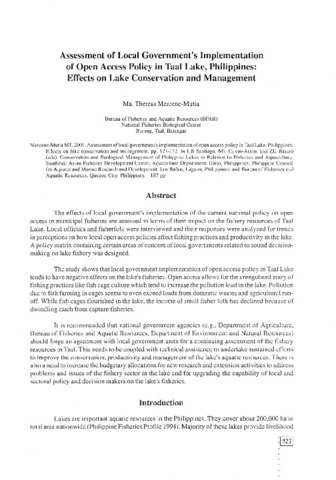A limnological survey of Lake Duminagat, Mt. Malindang Natural Park, Misamis Occidental, Philippines
- Global styles
- MLA
- Vancouver
- Elsevier - Harvard
- APA
- Help

View/
Date
2005Author
Page views
5,620ASFA keyword
AGROVOC keyword
Geographic names
Metadata
Show full item record
Share
Abstract
Lake Duminagat is a crater lake located in Mt. Malindang Natural Park, one of the protected areas in the Philippines. Two communities are adjacent to it - Brgy. Duminagat, of which it is a part, and Brgy. Gandawan. Both barangays are part of the municipality of Don Victoriano, province of Misamis Occidental. The municipality of Don Victoriano is entirely circumscribed by the Park which represents the flora and fauna of the Zamboanga biogeographic zone. This paper focuses on the objective of characterizing the limnology of Lake Duminagat - its morphology, its physico-chemical components and its biota.
The area of study consists of valleys and mountains. Brgy. Gandawan, Brgy. Lake Duminagat, and the lake basin are considered as crater valleys, surrounded by variably tall mountains. Being at a high elevation (~1,240 to 1,560 masl), the climate in the Lake Duminagat area is cooler compared to the lowlands. The area belongs to the region classified as Intermediate B type with no very pronounced maximum rain period and no dry season. Annual rainfall is 2099 mm.
Lake Duminagat is a small lake, with an area of 8.04 ha, maximum depth of 20.95 m, water volume of 933,000 m3, mean depth of 11.6 m, shoreline length of 1,060 m, and shoreline development of 1.054. It is a thermally stratified lake, though whether it undergoes periodic mixing was not determined. The water is low in alkalinity and is very soft. The water at the middle of the lake is potable enough for drinking at various times of measurement. Its various morphometric and physico-chemical characteristics such as a low surface area to volume ratio, low lake area to watershed area ratio, low alkalinity, and low amount of dissolved solids all contribute to its low productivity. Its macrophytes (representing one component of primary productivity) and zooplankton (representing secondary productivity) populations are thus low in numbers, aside from being limited in number of species. Consequently, the fish population, which is at the top of the aquatic food chain, is also low in kind, numbers, and biomass. Nonetheless, the lake supports a high diversity of indigenous shoreline fauna and flora. Considering the lake s characteristics and that of its surrounding community, one potential for the Lake Duminagat area is its use for ecotourism with the local people being the hosts-entrepreneurs.
The project, of which this paper is a part, was one of the projects in the Philippines-Netherlands Biodiversity Research Programme for Development: Focus on Mt. Malindang and Environs (shortened as BRP). The project used participatory approaches and involved the community as local researchers or partners. It is hoped that their involvement in this research gave the local communities an awareness of the natural and social factors that determine/affect the Lake Duminagat ecosystem. It is also hoped that results of this research would be used and would empower the local communities to come up with a strategy for conserving and sustainably utilizing the lake s biodiversity and resources, and improve livelihood and cultural opportunities.
Suggested Citation
Hansel, C. G., Poblete, T. O., Quimpang, V. T., Lumactud, R. A. C., Ganob, D., Lumimas, E., Lumimas, M., Pacut, L., & Panchito, R. (2005). A limnological survey of Lake Duminagat, Mt. Malindang Natural Park, Misamis Occidental, Philippines. In M. L. Cuvin-Aralar, R. S. Punongbayan, A. Santos-Borja, L. V. Castillo, E. V. Manalili, & M. M. Mendoza (Eds.), Proceedings of the First National Congress on Philippine Lakes (pp. 20-39). Southeast Asian Regional Center for Graduate Study and Research in Agriculture (SEARCA).
Type
Conference paperISSN
1656-8099Collections
- LakeCon2003 [49]
Related items
Showing items related by title, author, creator and subject.
-
An environmental assessment of the aquaculture potential of Lake Gawaan, Lake Lenneng and Lake Banao/Danum at the Mt. Province
Dang-awan, Rebecca G.; Estima, Martha; Gayagay, Petra; Pagtan, Aida; Ramos, Ma. Abegail A. (Aquaculture Department, Southeast Asian Fisheries Development Center; Philippine Council for Aquatic and Marine Research and Development (PCAMRD), Department of Science and Technology; Bureau of Fisheries and Aquatic Resources, 2001)This study reviews the existing conditions of the three Mt. Province lakes: Lake Gawaan, Lake Lenneng and Lake Banao/Danum. Three mechanisms were employed. First is the overview of the resource capabilities. This includes ... -
Changes in lake morphology as source of basic information for lake management: A case study on Laguna Lake, Philippines
Siringan, Fernando P.; Jaraula, Caroline Marie B. (Southeast Asian Regional Center for Graduate Study and Research in Agriculture (SEARCA), 2005) -
Assessment of local government's implementation of open access policy in Taal Lake, Philippines: Effects on lake conservation and management
Mercene-Mutia, Ma. Theresa (Aquaculture Department, Southeast Asian Fisheries Development Center; Philippine Council for Aquatic and Marine Research and Development (PCAMRD), Department of Science and Technology; Bureau of Fisheries and Aquatic Resources, 2001)The effects of local government's implementation of the current national policy on open access in municipal fisheries are assessed in terms of their impact on the fishery resources of Taal Lake. Local officials and fisherfolk ...





